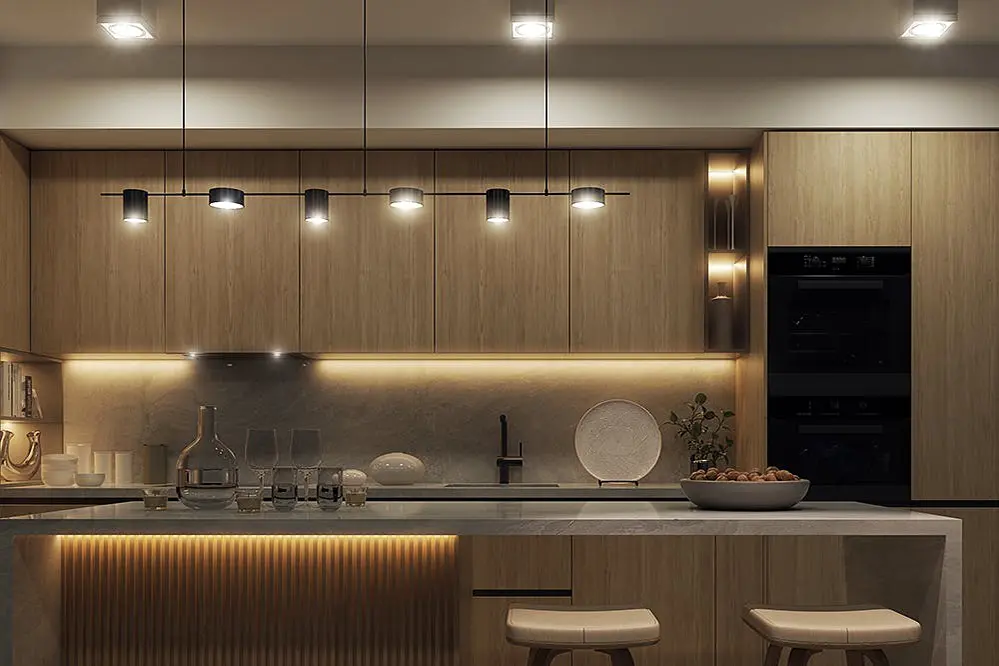How to choose the right color lighting for a kitchen is a common dilemma many homeowners face. Have you ever struggled with poor lighting in your kitchen, making it difficult to cook or entertain guests? The significance of selecting the appropriate lighting, including the right color temperature, cannot be overstated, as it directly impacts the functionality and ambiance of the kitchen.
Choosing the right color lighting involves considering various factors, such as kitchen design, color temperature, and placement. Warm lighting from the appropriate fixture can create a cozy, inviting atmosphere, while cooler tones can make the space feel more modern and clean. Understanding these options can help you make the best choice for your kitchen.
In this article, we will explore the different lighting options available and how they can transform your kitchen. By the end, you’ll have the knowledge to make informed decisions that enhance both the functionality and aesthetics of your space.
Let’s uncover the details and find the perfect lighting solution for your kitchen!
Understanding Kitchen Lighting Basics
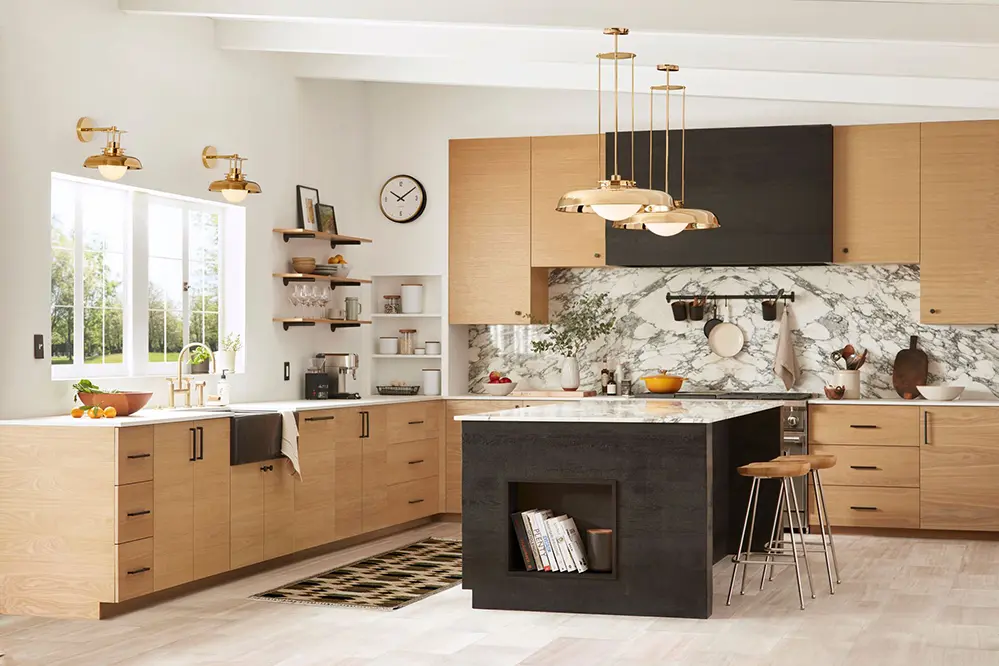
One must understand different types of lighting available for kitchens. Ambient lighting is essential.
They should also consider task lighting to brighten specific work areas.
Accent lighting can create visual interest and highlight certain features in the kitchen.
A layered approach to lighting maximizes both functionality and aesthetics. This strategy includes combining ambient, task, and accent lighting to create a versatile and inviting environment. By strategically planning these elements, including choosing fixtures with the right lumens, they can master the art of kitchen lighting.
Types of Kitchen Lighting
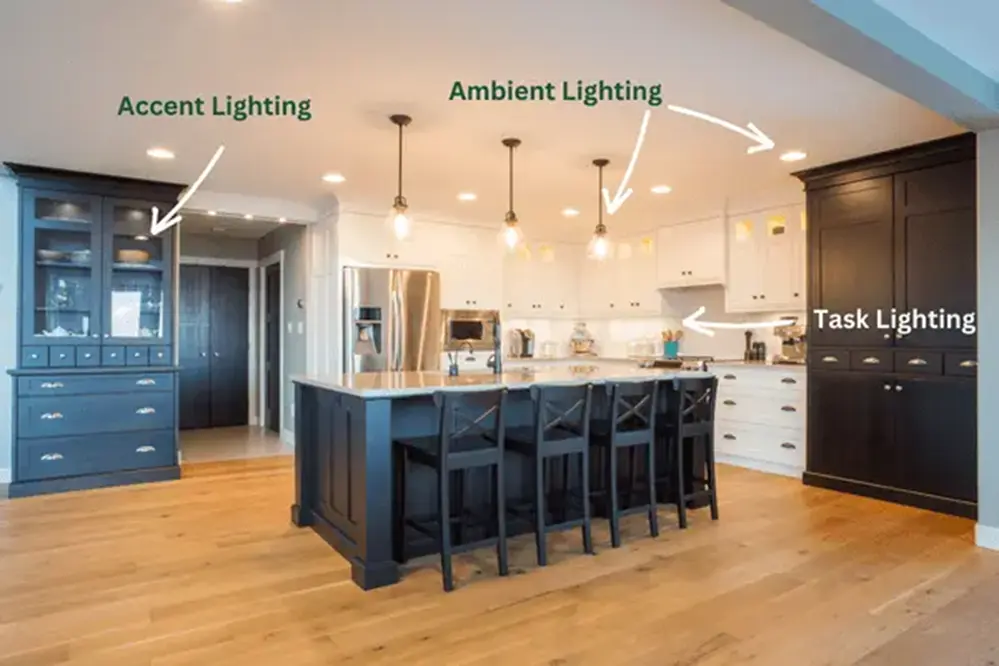
When exploring how to choose the right color lighting for a kitchen, it’s crucial to understand various lighting types. Ambient lighting provides general illumination, ensuring visibility and safety, with color temperature playing a crucial role in setting the overall mood. Task lighting focuses on specific work areas, enhancing precision in cooking activities. Accent lighting adds depth and highlights distinctive features, creating a visually captivating space. With a balanced blend of these three types, one can achieve a harmonious and functional kitchen environment pulsating with both warmth and practicality.
Ambient Lighting
Ambient lighting serves as the foundation, enveloping the kitchen in a consistent layer of illumination.
Soft, diffused ambient lighting enhances the overall atmosphere, setting a welcoming tone for all activities.
By distributing light evenly, ambient lighting minimizes shadows and promotes a sense of openness, ensuring the space feels expansive. It’s crucial for ambient lighting to provide sufficient brightness, creating a safe and functional environment for everyday tasks.
Installing dimmable fixtures allows for customizable ambient lighting, adapting effortlessly to various needs. This flexibility provides the opportunity to shift between a vibrant, energetic space and a cozy, relaxed setting with ease.
Task Lighting
Task lighting is vital for ensuring all kitchen tasks are performed safely and efficiently.
- Under-Cabinet Lights: Provide direct light on countertops.
- Pendant Lights: Ideal above kitchen islands or dining areas.
- Recessed Lights: Discreet yet effective for targeted illumination.
- Track Lighting: Flexible options for various task areas.
Effective task lighting reduces strain and enhances precision for cooking, chopping, and cleaning.
Consider combining different forms of task lighting for layered, balanced illumination.
Properly implemented task lighting transforms a kitchen into a more functional and enjoyable workspace.
Accent Lighting
Accent lighting in the kitchen adds visual interest and draws attention to particular features.
- Spotlights: Highlight artwork or architectural elements.
- LED Strips: Under-cabinet accents create a modern look.
- Toe-Kick Lights: Illuminate the floor, adding depth and safety.
- Above-Cabinet Lighting: Enhances ceiling height and ambiance.
Incorporating accent lighting elevates kitchen aesthetics, making the space more inviting.
It’s essential to balance accent lighting with task and ambient lighting for a cohesive design.
Factors to Consider
When determining how to choose the right color lighting for a kitchen, consider the kitchen’s overall design, including wall colors, cabinetry, and countertops. Different color temperatures can either complement or contrast with these elements, thereby influencing the room’s overall ambiance.
Lighting needs also depend on the kitchen’s primary activities, such as cooking, dining, or entertaining. Opt for “warm white” lighting if the goal is a cozy, welcoming atmosphere, whereas “cool white” or “daylight” lighting can enhance brightness and visibility for detailed tasks. Balancing functionality with aesthetic appeal ensures the lighting choice aligns with the kitchen’s purpose and enhances its beauty.
Kitchen Layout
A well-planned kitchen layout is essential for functionality and aesthetics.
- Galley Kitchens: Efficient for small spaces with parallel countertops.
- L-Shaped Kitchens: Ideal for open-plan spaces, offering ample corner storage.
- U-Shaped Kitchens: Perfect for large kitchens, maximizing cabinet and counter space.
- Island Kitchens: Adds extra counter space, serving as a central hub for activities.
- Peninsula Kitchens: Offers a versatile extension for additional seating or prep work.
A galley kitchen is highly efficient for those with limited space.
L-shaped layouts accommodate open floor plans and enhance kitchen flow.
A U-shaped layout offers abundant counter and cabinet space for larger kitchens.
Natural Light
Natural light is an essential component when considering how to choose the right color lighting for a kitchen.
Harnessing natural light effectively can transform the kitchen space, making it feel more inviting.
Positioning windows strategically to maximize sunlight can significantly contribute to a kitchen’s warmth and ambiance, fostering a sense of openness, cleanliness, and vitality.
For those fortunate enough to have access to ample natural light in their kitchen, there is the choice to complement it with accent lighting that enhances the overall brightness, or to use it as a primary light source during daylight hours. This method not only optimizes energy efficiency but also cultivates a harmonious kitchen atmosphere.
Personal Style
Creating a kitchen that reflects personal taste is crucial for a harmonious living space.
- Assess Preferences: Determine if a cozy, vibrant, or elegant style suits best.
- Consider Color Palette: Choose lighting that complements the chosen color scheme.
- Match Fixtures: Opt for lighting fixtures that align with their decor style.
- Balance Function and Aesthetics: Ensure lighting serves both practical and visual needs.
- Experiment: Don’t hesitate to try different options to find the perfect fit.
A deep understanding of one’s personal style can guide color lighting choices effectively.
Selecting lighting that matches their aesthetic while providing functionality is essential.
How to Choose the Right Color Lighting for a Kitchen
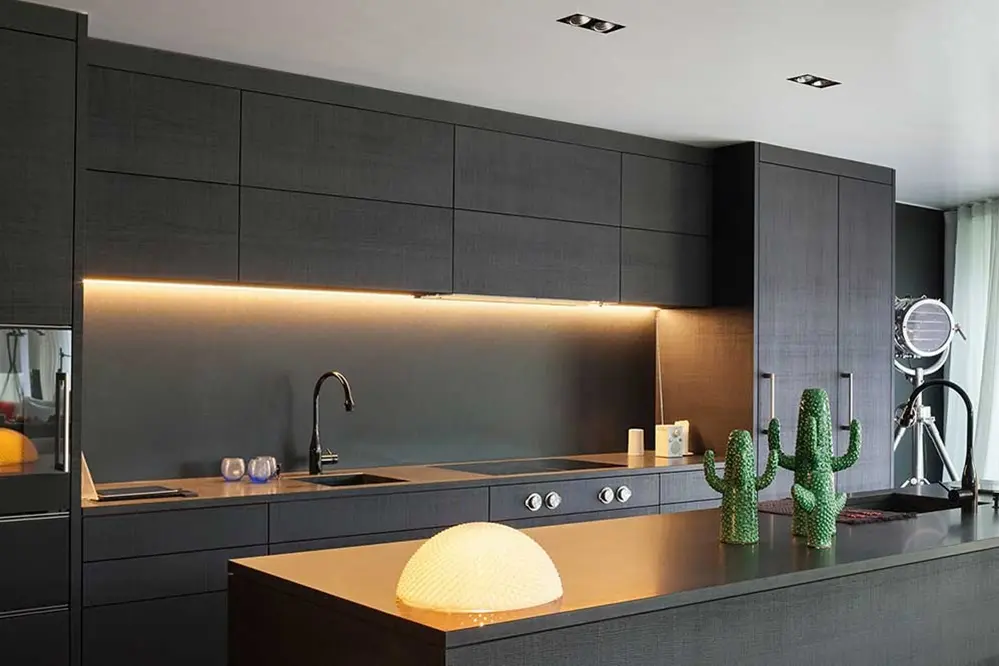
Choosing the right color lighting and color temperature for a kitchen can transform it into an inviting space that enhances productivity.
Since 2016, numerous advancements in lighting technology have offered more options than ever before, facilitating tailored solutions for various needs and preferences.
Therefore, it’s crucial to consider what ambiance they wish to create and how lighting can complement the kitchen’s overall design and functionality.
Warmer tones often evoke a sense of coziness and hospitality, making them ideal for relaxed, homey environments, while cooler tones can provide clarity and focus in contemporary, clean-lined spaces.
Ultimately, thoughtful lighting choices can elevate the kitchen’s appeal, making it both beautiful and efficient.
Warm vs. Cool Lighting
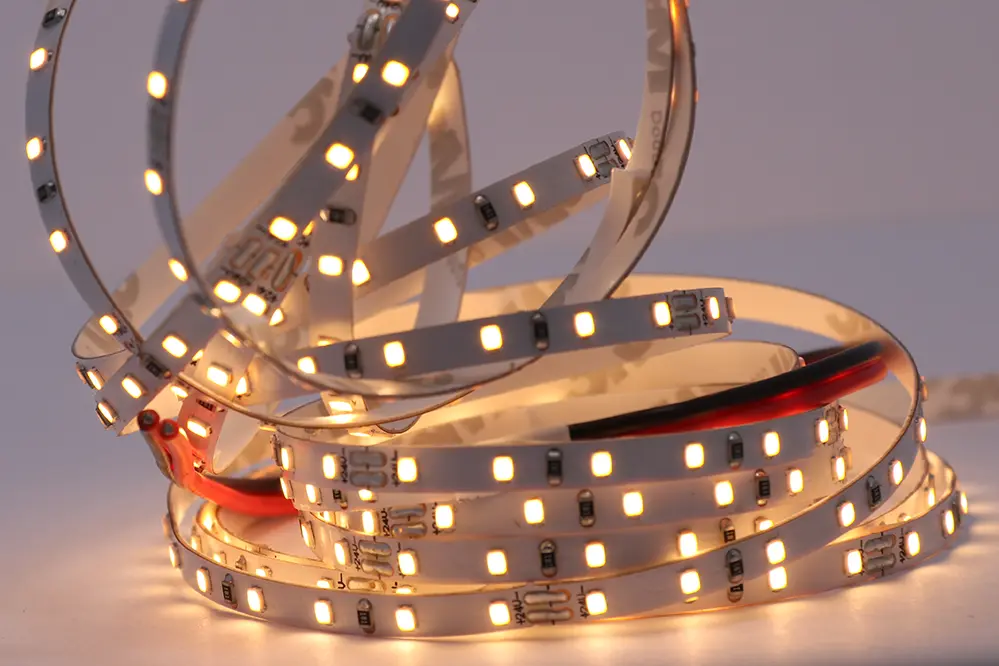
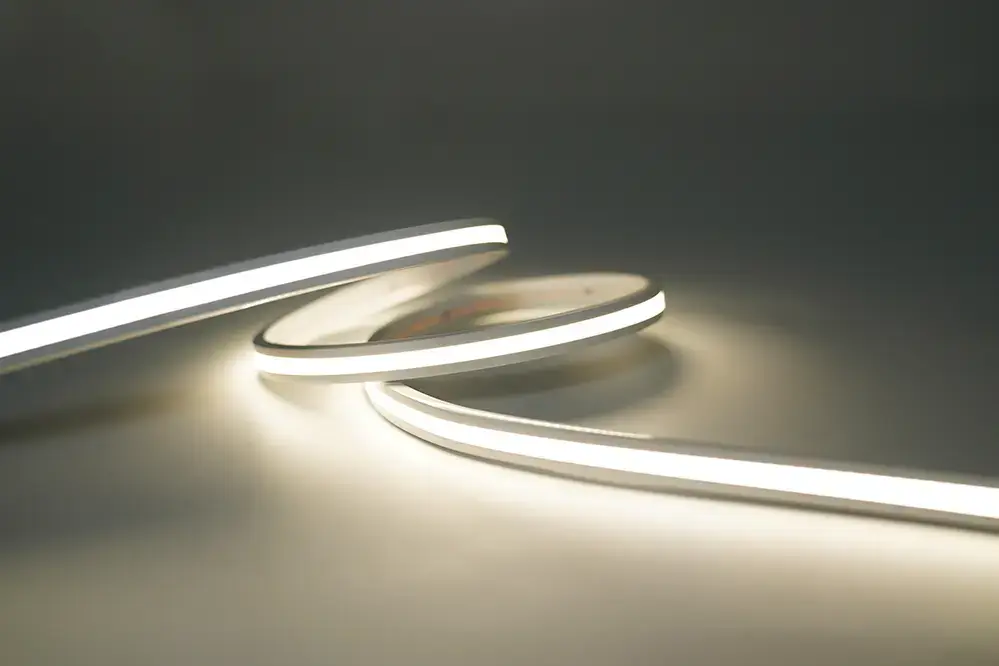
When deciding between warm and cool lighting, a myriad of considerations arise. Warmer lighting creates a welcoming ambiance, perfect for fostering intimate gatherings and leisurely meals. Conversely, cooler lighting can invigorate the space, enhancing visibility and lending a sleek, modern touch. By balancing these elements, one can cultivate a kitchen environment tailored to both their functional requirements and personal style preferences, ensuring an atmosphere that is both inviting and efficient.
Benefits of Warm Lighting
Warm lighting, normally around 3000K(Kelvin), has a unique ability to create a comforting atmosphere that promotes relaxation and tranquility.
In 2016, research highlighted how warmer lighting positively impacts emotional well-being, fostering feelings of comfort and security within domestic spaces. It’s no wonder that warm lighting has become a staple in kitchens where families gather and memories are made.
Moreover, it’s been shown that warm light can enhance one’s appetite, making it a popular choice for dining areas. Utilizing warm lighting in the kitchen can make meal times more enjoyable and the environment more appetizing.
Even from a design perspective, warm light has the versatile advantage of being flattering on various surfaces and finishes, emphasizing the rich textures of wood, stone, and other materials commonly found in kitchens.
Choosing warm lighting ultimately contributes to a kitchen’s inviting nature, blending utility with coziness, and making it a haven for culinary exploration and cherished moments.
Benefits of Cool Lighting
Cool lighting illuminates with exceptional clarity.
It creates an environment that is crisp and vibrant. This kind of lighting is ideal for tasks that require precision, such as chopping vegetables, reading recipes, or meticulously cleaning kitchen surfaces. Furthermore, cool lighting can aid in enhancing concentration and focus, making it the quintessential choice for those detailed culinary adventures.
Their versatility extends naturally to contemporary designs.
Cool light, normally around 6000K(Kelvin) works well in spaces that need a fresh, modern look. It reflects a clean aesthetic, complementing stainless steel appliances and sleek countertops or backsplashes.
Finally, it is important to consider that cool lighting can help maintain alertness. Studies have demonstrated that cooler light temperatures can reduce eye strain, promoting a healthier kitchen environment while simultaneously enhancing the visual appeal of the space.
Selecting LED Strips

When selecting LED strips, one should consider the color temperature, brightness level, and compatibility with existing fixtures. These factors will ensure the chosen lighting complements the kitchen’s design and facilitates all necessary tasks.
In addition to these criteria, the placement of LED strips is crucial. Under-cabinet areas often benefit from “task lighting.” Here, it is essential to select strips with a higher lumen output, providing sufficient illumination. By carefully positioning the strips, not only can the kitchen become more functional, but their strategic placement can also elevate the overall ambiance.
Energy Efficiency
Energy efficiency in kitchen lighting can significantly lower utility bills while helping the environment.
When considering how to choose the right color lighting for a kitchen, energy efficiency should be a paramount factor. Opting for LED lighting, for instance, ensures that one benefits from extended longevity and substantial energy savings. LEDs typically use about 75% less energy than incandescent bulbs and last 25 times longer.
Furthermore, LED lights are available in a spectrum of color temperatures, making them ideal for any kitchen atmosphere. They produce less heat, reducing cooling costs during warmer months. By selecting the appropriate color and placement, homeowners can maximize these benefits without compromising on aesthetics.
Ultimately, energy-efficient lighting solutions not only enhance visual appeal but also promote sustainability. By integrating smart lighting controls, such as dimmers and sensors, consumers can further enhance energy savings, tailoring illumination levels to specific tasks and times of the day. This holistic approach brings efficiency and beauty into harmony within the modern kitchen space.
Lifespan
When considering how to choose the right color lighting for a kitchen, the lifespan of the lighting source is paramount. LED lighting stands out because of its extraordinary longevity, offering tens of thousands of hours of reliable illumination.
LED lights typically have much longer lifespans compared to incandescent bulbs. This longevity translates into fewer replacements and lower maintenance costs.
In contrast, traditional incandescent bulbs may burn out frequently, causing inconvenience. By comparison, LED lighting can often last for years before needing replacement.
Moreover, the consistent performance over time makes LEDs a favored option for homeowners seeking reliable kitchen lighting. It fosters an uninterrupted and pleasant atmosphere.
Research indicates that LED lighting can function efficiently for up to 50,000 hours. This impressive figure equates to nearly two decades of average household use, demanding minimal interventions.
Ultimately, choosing long-lasting lighting not only reduces costs but also promotes environmental sustainability. Lifelong performance blends economic and ecological advantages seamlessly.
Mixing Lighting Colors
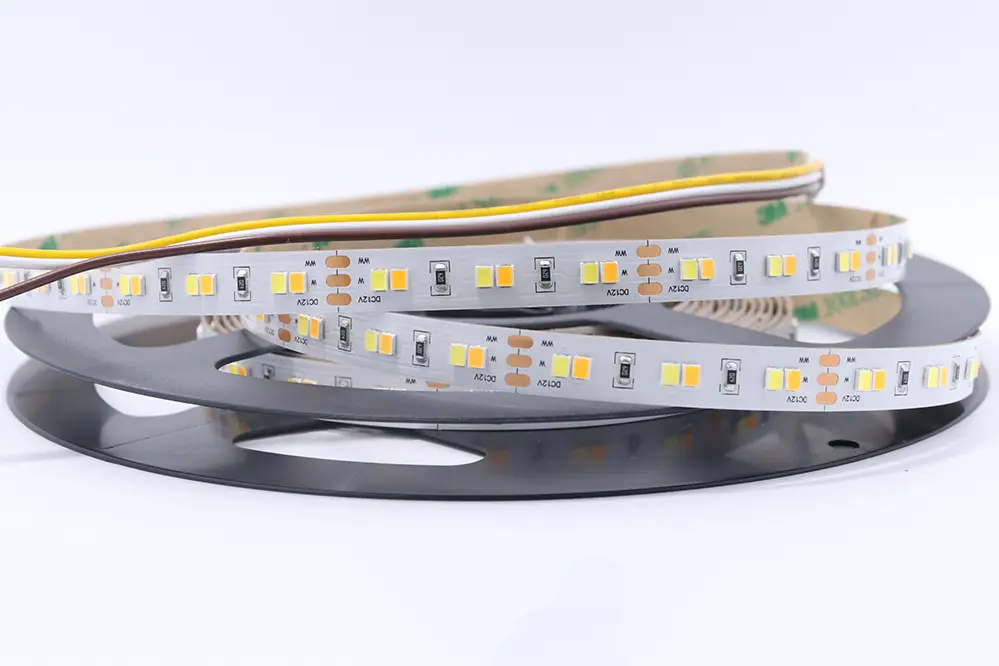
Mixing lighting colors enhances kitchen ambiance.
Achieving the perfect blend of lighting colors is an art. The key lies in understanding the specific functions of various lighting options, such as task lighting, ambient lighting, and accent lighting. Strategically, they work to create layers of illumination that render functionality and beauty seamlessly.
Choosing different lighting colors.
An example of effective lighting color use is combining warm and cool lights. Warm light instills a cozy and inviting atmosphere, ideal for dining areas. In contrast, cool light is perfect for workspaces like countertops and islands, enhancing visibility and focus.
The harmonious interplay of these lighting hues can transform a kitchen from a solely utilitarian space into an inviting environment. By thoughtfully selecting and mixing lighting colors, one can achieve a well-lit and aesthetically pleasing kitchen, conducive to both culinary creativity and social interactions.
Installation Tips
Choosing the right fixtures matters.
Before diving into the installation process, they should plan meticulously. This includes measuring the areas that require illumination and analyzing the most effective placement to ensure optimal light distribution. Ideally, they should also consider the electrical outlet locations and the potential need for new wiring.
It requires professional expertise.
They must verify if their chosen lighting fixtures align with the existing electrical capacity. While some homeowners might feel confident in a do-it-yourself installation, others may opt to hire a licensed electrician to guarantee safety and compliance with local codes.
Positioning is crucial.
The strategic placement of lighting fixtures can significantly impact the kitchen’s ambiance and functionality. By having an understanding of how light interacts with different surfaces and textures, they can optimize their lighting setup for both aesthetics and practicality.
Regular maintenance ensures longevity.
Finally, regular maintenance, such as checking for loose connections and replacing outdated bulbs, will ensure that the kitchen lighting remains effective and visually appealing. Properly installed and well-maintained lighting can elevate the overall kitchen experience, fostering an inspiring environment for both everyday tasks and special occasions.
Conclusion
Choosing the right color lighting for a kitchen is essential for creating an inviting atmosphere. Understanding color temperature and the effects of different lighting types on surfaces helps enhance both aesthetics and functionality. A balanced mix of ambient, task, and accent lighting ensures versatility and adaptability. Regular maintenance and thoughtful planning preserve the lighting’s integrity, making the kitchen more enjoyable and inspiring.
For those looking to elevate their kitchen lighting, consider reaching out to Unitop, a professional Chinese manufacturer of LED strip lights and LED neon strips. With their expertise and high-quality products, Unitop can help you achieve the perfect balance of ambient, task, and accent lighting to transform your kitchen into a functional and visually stunning space. Their innovative solutions and commitment to excellence ensure that your lighting setup will not only meet but exceed your expectations. Contact Unitop today to explore their range of LED lighting options and bring your kitchen lighting vision to life.
